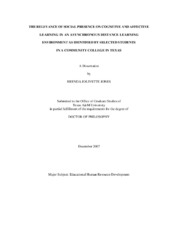| dc.contributor.advisor | Egan, Toby Marshall | |
| dc.creator | Jones, Brenda Jolivette | |
| dc.date.accessioned | 2010-01-15T00:12:16Z | |
| dc.date.accessioned | 2010-01-16T00:36:40Z | |
| dc.date.available | 2010-01-15T00:12:16Z | |
| dc.date.available | 2010-01-16T00:36:40Z | |
| dc.date.created | 2007-12 | |
| dc.date.issued | 2009-05-15 | |
| dc.identifier.uri | https://hdl.handle.net/1969.1/ETD-TAMU-2493 | |
| dc.description.abstract | The distance learning environment is one that involves a complex array of
factors that influence a learner’s perspective of presence, satisfaction, and learning. This
study was designed to investigate Lee College freshmen and sophomore students’
perceptions of social presence. The purpose of the study was to (a) determine whether
or not differences in perceptions of social presence exist among participants who differ
in gender, age, and total level of education and (b) investigate whether or not there was
a relationship between the participants’ perceptions of social presence and their online
course activities in WEBCT®. This study was conducted using a questionnaire. The
data were collected from a convenience sample of 252 freshmen and sophomore level
students at Lee College in Baytown, Texas. A response rate of 62% resulted in a final
sample of 156.
The content validity of the questionnaire was established via expert opinion, and
the internal consistency and reliability of the instrument was calculated using
Cronbach’s α. Data screening techniques were employed as the first step in the data analysis process. Frequency counts, central tendencies, and standard deviations were
used in the descriptive analysis of the data obtained via the questionnaire. Correlations
and one-way ANOVAS were employed to answer research question 1 regarding the
participants’ perceptions of social presence and their personal characteristics (i.e.,
gender, age, and their total number of college credits earned). Six conclusions were
generated regarding the participants’ perceptions of social presence and their gender,
age, and total number of college credits earned.
Principal factor analysis with Varimax rotation revealed six constructs for
research question 2 regarding the online course activities in WEBCT®. Differences in
the participants’ perceptions of social presence in the six constructs for the online
course activities in WEBCT® were obtained. A stepwise regression analysis was
conducted to obtain additional information regarding the amount of explained variance
added by each of the respective predictors. Cronbach’s alpha was used to assess
reliability of the data. Twelve conclusions were generated for research question 2
regarding the participants’ perceptions of social presence and the online course
activities. Specific human resource development practices were suggested. | en |
| dc.format.medium | electronic | en |
| dc.format.mimetype | application/pdf | |
| dc.language.iso | en_US | |
| dc.subject | Social Presence | en |
| dc.subject | Online Learning | en |
| dc.subject | Cognitive Learning | en |
| dc.subject | Affective Learning | en |
| dc.title | The relevance of social presence, on cognitive learning, and affective learning, in an asynscronous distance learning environment, as identified by selected community college, students in texas | en |
| dc.type | Book | en |
| dc.type | Thesis | en |
| thesis.degree.department | Educational Administration and Human Resource Development | en |
| thesis.degree.discipline | Educational Human Resource Development | en |
| thesis.degree.grantor | Texas A&M University | en |
| thesis.degree.name | Doctor of Philosophy | en |
| thesis.degree.level | Doctoral | en |
| dc.contributor.committeeMember | Lindner, James | |
| dc.contributor.committeeMember | Lynham, Susan | |
| dc.contributor.committeeMember | Rolle, Anthony | |
| dc.type.genre | Electronic Dissertation | en |
| dc.type.material | text | en |
| dc.format.digitalOrigin | born digital | en |


